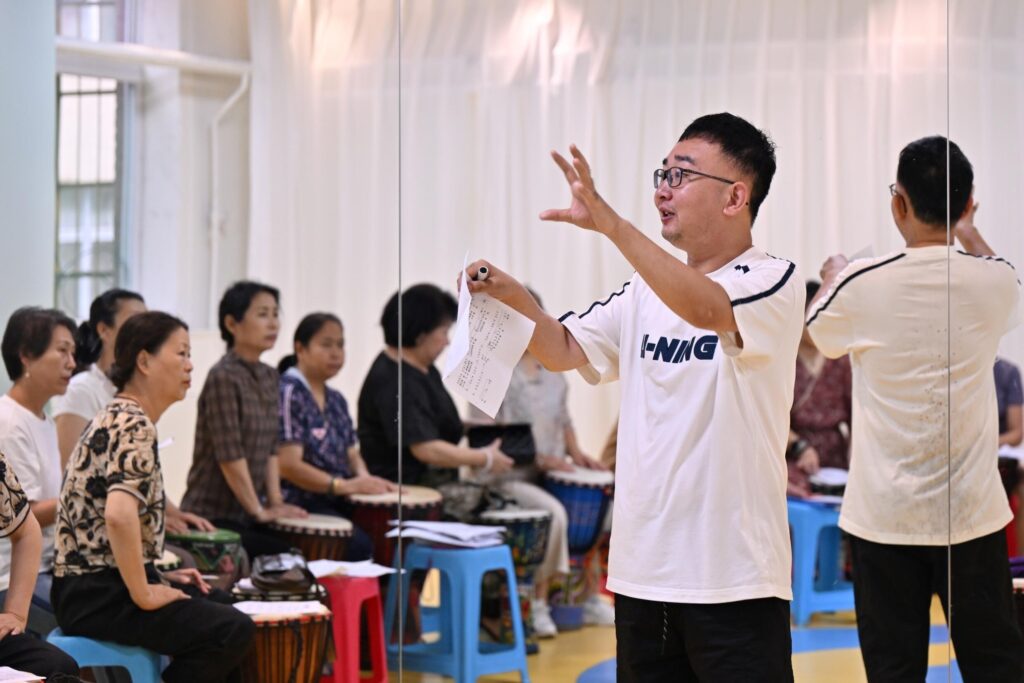This picture taken on July 2, 2024 shows Lei Fangyan (R) gesturing as he teaches African drums at a kindergarten-turned-elderly centre in Taiyuan, in China’s northern Shanxi province.
A New Chapter for Kindergartens
In northern China, senior citizens dance to old-time tunes at a former kindergarten. Educators have shifted focus from children to seniors due to the aging population and low birth rate. This change reflects a nationwide trend as China’s demographics evolve rapidly.
Facing Demographic Changes
Official statistics reveal that hundreds of millions of Chinese will enter old age in the coming decades. Meanwhile, the country’s birth rate remains chronically low. This demographic shift affects many sectors, including education. Thousands of preschools have closed as enrollments decline. However, some institutions have adapted, like one in Shanxi province.
Transformation in Shanxi
In Shanxi, a kindergarten has transitioned to a senior care center. Principal Li Xiuling, 56, shared her experience. “The problem became evident as the number of children decreased,” she said. Her preschool, founded in 2005, once served 280 children but closed last year. It reopened in December as “Impressions of Youth,” a recreational center for retirees. Now, around 100 adult learners engage in music, dance, and other activities.
Embracing New Opportunities
Li believes this change is progressive. “They come to fulfill dreams they had when young,” she said. On a rainy morning, a modeling instructor led older women in traditional dresses around a classroom. In another class, students played African drums to socialist songs. He Ying, 63, found new confidence and friends at the center. “I used to feel my cultural life was impoverished,” she said. “People here are not just waiting to grow old.”
Nationwide Trend
Nearly 15,000 kindergartens closed last year as enrollments dropped by 5.3 million. In industrial Shanxi, deaths outnumbered births by 78,000 last year. The center’s past remains visible with bunk beds and desks in former classrooms. Yan Xi, who now teaches retirees, found the transition challenging. “Little kids believe whatever you say, but the elderly have their own ways,” she said.
Senior Education on the Rise
Several facilities in China have successfully pivoted from preschool to senior education. Student Sun Linzhi, 56, sees this shift as meeting a need for “universities for the elderly.” Since joining the center, Sun feels rejuvenated. “I feel like I’m young again,” she said.
The Growing “Silver Economy”
China’s senior population rose by nearly 17 million last year. Seniors now make up over 20 percent of the population. This proportion could reach nearly a third by 2035. Beijing plans to establish a national elderly care system by 2025. However, the country still lacks enough nursing homes and faces regional disparities. Top leaders are discussing the “silver economy” at a key economic meeting. The government estimates that senior-related products and services could be worth 30 trillion yuan by 2035.
Nostalgia and Adaptation
Li, the principal, feels nostalgic for the days when her school was full of children. “I was very emotionally invested in it,” she said, gesturing towards the disused bunks and desks. “We kept those as a kind of memento.”
China’s kindergartens are transforming to meet the needs of an aging population. This shift highlights the country’s demographic challenges and the innovative responses emerging. As senior citizens find new opportunities in these converted centers, the nation continues to adapt to its changing population.



